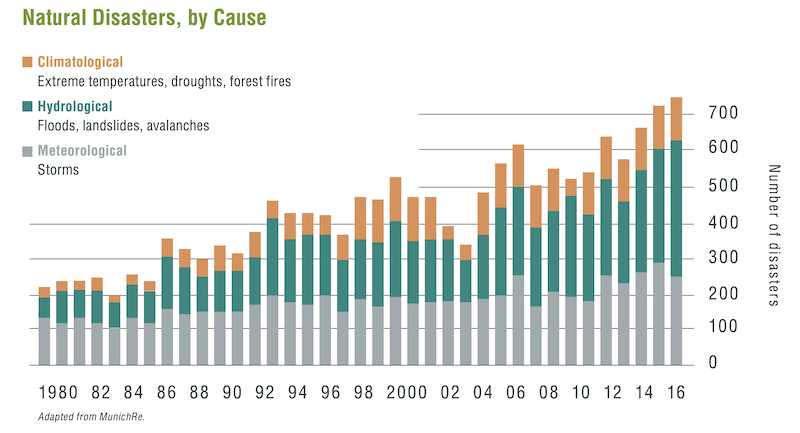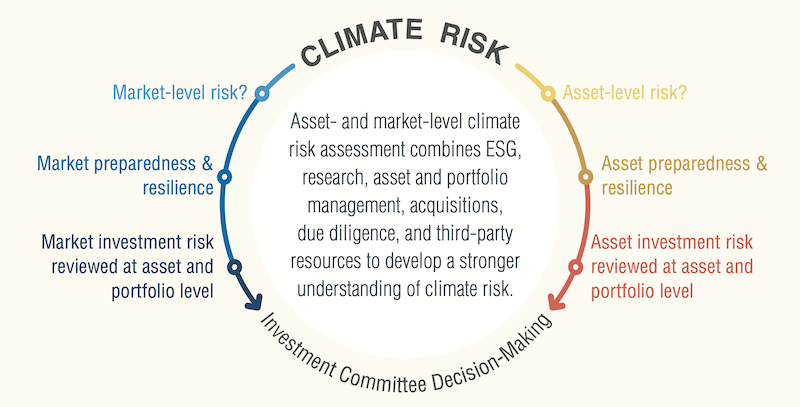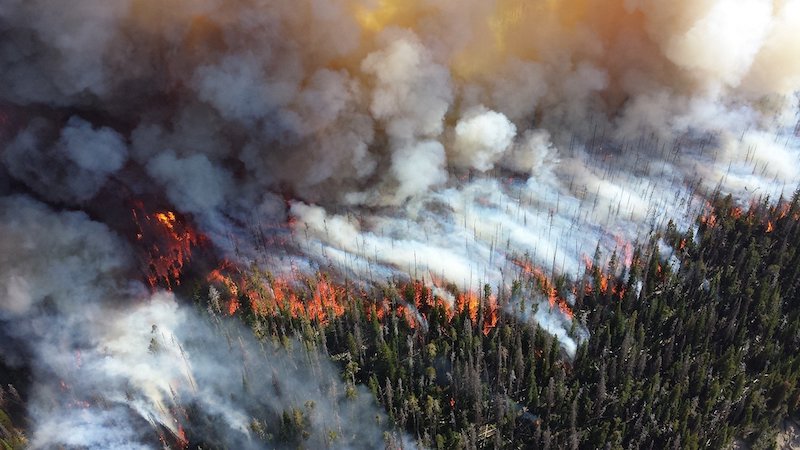The consensus among leading real estate investors is that market-scale climate risk assessment will play a role in future investment decisions, mirroring the recent advances in assessing physical risk at the asset level. However, valuation still lags recognition of climate risk. And investors question whether adaptation and resilience actions by high-risk cities sufficiently respond to the extent of the risk faced, and ultimately what the overall impact of real estate will be.
These are some of the conclusions of Climate Risk and Real Estate: Emerging Practices for Market Assessment, the latest study on this topic from the Urban Land Institute and Heitman, a real estate investment management firm, that dives into how forward-thinking real estate investors factor climate change into their business decisions.
The report is based, in part, on recent interviews with 28 major real estate investors and developers ranging from Arcadis, Goldman Sachs, and LaSalle to the City of Rotterdam. Arup and the actuarial firm Milliman contributed insights into specialist areas such as measuring city fiscal health and catastrophe models “that enrich our understanding of what tools we need to assess, price, and address climate risk.”
WEATHER EVENTS MORE FREQUENT AND FEROCIOUS
That risk has rarely been more palpable. Worldwide losses from extreme weather events from 2010 to 2020 totaled over $3 trillion, $1 trillion more than the previous decade. Over the past few months alone, wildfires in California have scorched four million acres of land and displaced 200,000 residents.
A 2019 study by Deloitte found that more than half of U.S. state insurance regulators “indicated that climate change was likely to have a high impact or an extremely high impact on coverage availability and underwriting assumptions.” And earlier this year, Larry Fink, CEO of BlackRock, the world’s largest asset manager, warned that climate change was now “a defining factor in companies’ long-term prospects.” He added “we are on the edge of a fundamental reshaping of finance.”
Real estate investment managers interviewed for the ULI-Heitman report noted that they are seeing increases in property insurance premiums, a trend many of those investors attributed to climate change and the increased frequency of storm events. In an extreme scenario, some investors envisioned a future where properties can’t qualify for insurance and therefore can’t borrow. In short, a loss of insurance could cause a downward spiral even in the absence of a peak climate event. Even without a worst-case scenario, the annual insurance pricing structure can underpredict risk for longer hold periods as well as for infrastructure.

Anyway you call it, weather events are increasingly disastrous globally. Image: ULI and Heitman, data from MunichRe
INVESTORS SEARCHING FOR CLUES
Right now, it doesn’t appear as if investors are fleeing en masse from high-risk markets because of their fears of climate change. But the report identifies key considerations and next steps for the investment industry to improve awareness and understanding of market-level climate risk. These include:
•Developing strategies to measure market-level climate risk and resilience considering physical risk, resilient infrastructure, and public policy;
•Linking asset-level physical risk assessments with market-scale analysis;
•Exploring the role that the real estate industry plays in supporting funding mechanisms for future infrastructure and resilience initiatives;
•Facilitating collaboration between policymakers, chief resilience officers, and real estate investors and investment managers;
•Working with the insurance industry and actuaries to refine tools to reflect current and future climate risks; and
•Partnering with the valuation industry to accurately build climate change risk into appraisals.
MEASUREMENT TOOLS UNDERWHELMING
Perhaps the biggest challenge to climate-related risk assessment is the lack of qualitative measurement of climate change’s impact on cities and whether risk mitigation is enough. One investment manager interviewed for the report put in bluntly: “We have never found any [tools of frameworks] that cut to the chase and say, first, is this city impacted by climate change? And second, is the city’s reaction appropriate and sufficient given the risk?”
Compounding this problem is the lack of agreement among investors about how to qualify markets for climate risk in ways that incorporate vulnerability and resilience investments.
The study cites several considerations for climate-risk market analysis, including physical risk, city governance capacity, city resilience governance, building and land-use codes, and the extent, quality and implementation of a city’s resilience planning.
“The concept of urban resilience—and a city’s adaptive capacity in response to both major disruptions and chronic stresses—is fundamental to city governance,” the report states. That’s especially true today, as globally, most major economic hubs are in coastal, river delta, or other high-risk areas.
In 2020, McKinsey Global Institute explored Florida real estate as a theoretical example of this phenomenon, determining that if investments in flood preparedness are not made and flooding losses continue, homes in that state could be devalued by $30 billion to $80 billion, thereby leading to reductions in property tax revenue from 15 to 30 percent.

Investors are incorporating more factors into their risk management calculations. Image: ULI and Heitman
CATASTROPHE MODELING STILL NEEDS TWEAKING
The report observes that Investors are beginning to systematically follow how markets are making these infrastructure, policy, and investment decisions to contribute to their forecasts for the future economic health, vitality, and attractiveness of real estate investment in these markets.
But for catastrophe models to provide real estate investors with meaningful information, the report states that modifications are needed that take a longer-term focus on real estate value, and accept a dynamic view of the future.
The report warns, as well, that oversimplifying model results can lead to unintended consequences that undermine the risk management principles that the metrics were intended to support. “Under a changing climate, using a single-point estimate or metric that summarizes model results could be disastrous, as uncertainties compound over time.”
THINKING CREATIVELY ABOUT FUNDING
The report also touches on the need for cities to replace aging critical infrastructure as part of their resilience strategies. It notes that investments in stormwater management and coastal protection can have quality-of-life benefits. Some cities are also exploring value-capture strategies, where future high-value waterfront development would contribute funding to protective infrastructure nearby.
City governments implementing resilience plans are increasingly striving to make future investments in resilience in an equitable manner to ensure that all people benefit from climate solutions and to avoid further exacerbating patterns of discrimination.
Municipalities are also thinking outside the box when it comes to funding their resilience actions, looking beyond bond issues to explore partnerships with the private sector, whether through financial contribution, tax increment financing (TIF)-style funding districts, transfer of development rights, partnership in delivery of district-scale infrastructure, or by codifying resilience measures for new construction.
“In short, funding resilient infrastructure will require city staff to think creatively,” the report states.
Related Stories
Resiliency | Feb 15, 2022
Design strategies for resilient buildings
LEO A DALY's National Director of Engineering Kim Cowman takes a building-level look at resilient design.
Sponsored | Steel Buildings | Jan 25, 2022
Multifamily + Hospitality: Benefits of building in long-span composite floor systems
Long-span composite floor systems provide unique advantages in the construction of multi-family and hospitality facilities. This introductory course explains what composite deck is, how it works, what typical composite deck profiles look like and provides guidelines for using composite floor systems. This is a nano unit course.
Sponsored | Reconstruction & Renovation | Jan 25, 2022
Concrete buildings: Effective solutions for restorations and major repairs
Architectural concrete as we know it today was invented in the 19th century. It reached new heights in the U.S. after World War II when mid-century modernism was in vogue, following in the footsteps of a European aesthetic that expressed structure and permanent surfaces through this exposed material. Concrete was treated as a monolithic miracle, waterproof and structurally and visually versatile.
Sponsored | Resiliency | Jan 24, 2022
Norshield Products Fortify Critical NYC Infrastructure
New York City has two very large buildings dedicated to answering the 911 calls of its five boroughs. With more than 11 million emergency calls annually, it makes perfect sense. The second of these buildings, the Public Safety Answering Center II (PSAC II) is located on a nine-acre parcel of land in the Bronx. It’s an imposing 450,000 square-foot structure—a 240-foot-wide by 240-foot-tall cube. The gleaming aluminum cube risesthe equivalent of 24 stories from behind a grassy berm, projecting the unlikely impression that it might actually be floating. Like most visually striking structures, the building has drawn as much scorn as it has admiration.
Sponsored | Resiliency | Jan 24, 2022
Blast Hazard Mitigation: Building Openings for Greater Safety and Security
Microgrid | Jan 16, 2022
Resilience is what makes microgrids attractive as back-up energy controls
Jacobs is working with clients worldwide to ensure mission critical operations can withstand unexpected emergencies.
Sponsored | BD+C University Course | Jan 12, 2022
Total steel project performance
This instructor-led video course discusses actual project scenarios where collaborative steel joist and deck design have reduced total-project costs. In an era when incomplete structural drawings are a growing concern for our industry, the course reveals hidden costs and risks that can be avoided.
Resiliency | Oct 19, 2021
Achieving resiliency through integrated design
Planning for and responding to the effects of adverse shocks and stresses is typically what architects and engineers have always thought of as good standard design practices.
Resiliency | Aug 19, 2021
White paper outlines cost-effective flood protection approaches for building owners
A new white paper from Walter P Moore offers an in-depth review of the flood protection process and proven approaches.
Resiliency | Aug 19, 2021
White paper outlines cost-effective flood protection approaches for building owners
A new white paper from Walter P Moore offers an in-depth review of the flood protection process and proven approaches.

















